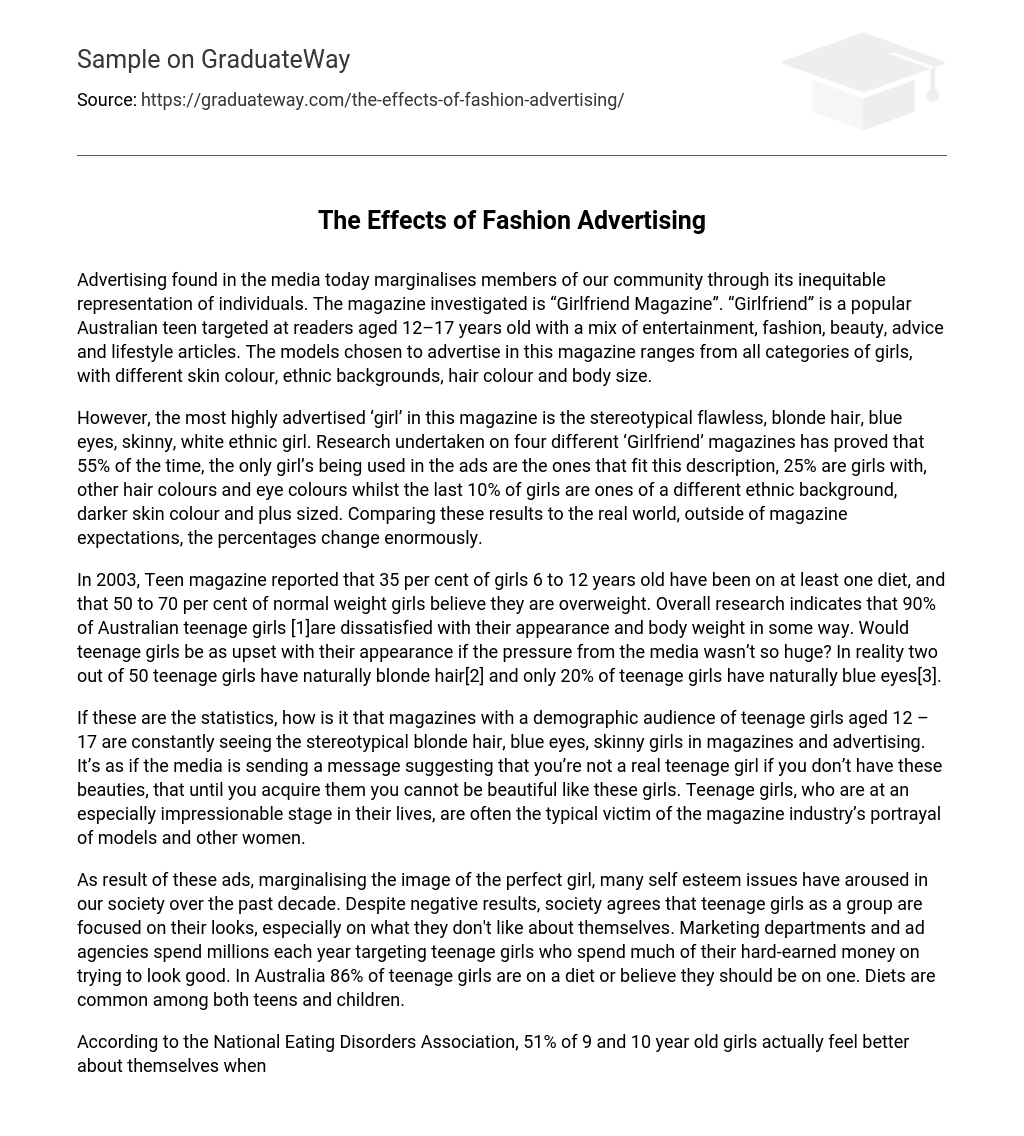Advertising found in the media today marginalises members of our community through its inequitable representation of individuals. The magazine investigated is “Girlfriend Magazine”. “Girlfriend” is a popular Australian teen targeted at readers aged 12–17 years old with a mix of entertainment, fashion, beauty, advice and lifestyle articles. The models chosen to advertise in this magazine ranges from all categories of girls, with different skin colour, ethnic backgrounds, hair colour and body size.
However, the most highly advertised ‘girl’ in this magazine is the stereotypical flawless, blonde hair, blue eyes, skinny, white ethnic girl. Research undertaken on four different ‘Girlfriend’ magazines has proved that 55% of the time, the only girl’s being used in the ads are the ones that fit this description, 25% are girls with, other hair colours and eye colours whilst the last 10% of girls are ones of a different ethnic background, darker skin colour and plus sized. Comparing these results to the real world, outside of magazine expectations, the percentages change enormously.
In 2003, Teen magazine reported that 35 per cent of girls 6 to 12 years old have been on at least one diet, and that 50 to 70 per cent of normal weight girls believe they are overweight. Overall research indicates that 90% of Australian teenage girls [1]are dissatisfied with their appearance and body weight in some way. Would teenage girls be as upset with their appearance if the pressure from the media wasn’t so huge? In reality two out of 50 teenage girls have naturally blonde hair[2] and only 20% of teenage girls have naturally blue eyes[3].
If these are the statistics, how is it that magazines with a demographic audience of teenage girls aged 12 – 17 are constantly seeing the stereotypical blonde hair, blue eyes, skinny girls in magazines and advertising. It’s as if the media is sending a message suggesting that you’re not a real teenage girl if you don’t have these beauties, that until you acquire them you cannot be beautiful like these girls. Teenage girls, who are at an especially impressionable stage in their lives, are often the typical victim of the magazine industry’s portrayal of models and other women.
As result of these ads, marginalising the image of the perfect girl, many self esteem issues have aroused in our society over the past decade. Despite negative results, society agrees that teenage girls as a group are focused on their looks, especially on what they don’t like about themselves. Marketing departments and ad agencies spend millions each year targeting teenage girls who spend much of their hard-earned money on trying to look good. In Australia 86% of teenage girls are on a diet or believe they should be on one. Diets are common among both teens and children.
According to the National Eating Disorders Association, 51% of 9 and 10 year old girls actually feel better about themselves when on a diet. As a society, our obsession with thin is relatively new. Most people (especially teens) are shocked to find that sex icon Marilyn Monroe actually wore a size 14. [4] Everywhere we look we find models that are thinner than 96% of all the girls and women in Australia. [5]Almost every celebrity shows skin nowadays and flaunts the perfect body off more then ever. Teenage girls are under the pressure constantly to want to change to look and be like these female models.
Pressure builds up so much and ways to look beautiful and loose weight seem so daunting and hard. Their self esteem drops and they commence to hate everything about themselves. They stop eating to loose weight which often leads to many cases of depression. Self harm can often be associated with media advertising as girl’s become so upset and depressed with themselves they begin to hurt themselves as a way of them escaping the reality that they don’t look beautiful like the models advertised through the media. In 2002, researchers at Flinders University in South Australia studied 400 teenagers regarding how they relate to advertising.
They found that girls who watched TV commercials featuring underweight models lost self-confidence and became more dissatisfied with their own bodies. Girls who spent the most time and effort on their appearance suffered the greatest loss in confidence. [6] In conclusion, magazines are responsible for many problems and incorrect stereotypes being forced on and negatively affecting teenagers today. The incorrect and negative stereotypes being shown by these magazines are giving young girls an incorrect impression and interpretation of the world and the people in it.
The overly skinny models cause havoc on the self-esteem of female readers and can cause eating disorders and personal insecurity. Readers of magazines intended for teenagers should beware of the possible effects of their harmful influence and take care that they, are not caught in the media advertising trap. Magazines need to begin to realise the negative and harmful effects that just an ad can have on a teenage girl.
Bibliography
“Teenage Girls + Media = Low Self Esteem”, November 2005, Ezine Articles, http://ezinearticles. com/? Teenage-Girls-+-Media-=-Low-Self-Esteem;id=96389 , 03/03/11, Yahoo Answers, 2006, “How many REAL blonde hair blue eye teenagers”, http://answers. yahoo. com/question/index? qid=20070924082255AAfzqXO, 09/03/11 Article Base, 2011, “How many natural blue eyed people? ”, Creative Commons License http://www. articlesbase. com/answers/how-many-blue-eyed-people-in-the-world-75753, 09/03/11 Media Stereotyping, 2010, Media Awareness Network http://www. media-awareness. ca/english/issues/stereotyping/women_and_girls/women_girls. cfm, 09/03/11 Thomas Waltz, November 2004, “The Effects of Magazines on the Self-Esteem and Portrayal of Stereotypes in Teenagers”, http://www. sl. mtu. edu/~tgwaltz/worksamples/Documents/SeniorCompResearchPaper. pdf, 09/03/11 [1] http://ezinearticles. com/? Teenage-Girls-+-Media-=-Low-Self-Esteem;id=96389 [2] http://answers. yahoo. com/question/index? qid=20070924082255AAfzqXO [3] http://www. articlesbase. com/answers/how-many-blue-eyed-people-in-the-world-75753 [4] http://ezinearticles. com/? Teenage-Girls-+-Media-=-Low-Self-Esteem;id=96389 [5] http://ezinearticles. com/? Teenage-Girls-+-Media-=-Low-Self-Esteem;id=96389 [6] http://www. media-awareness. ca/english/issues/stereotyping/women_and_girls/women_girls. cfm





